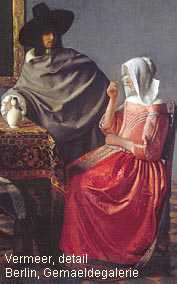 Either
a black woolen woman's dress, or a black man's gown, 'een
swarte laken tabbert; een swarte lakenrock', [a black
skirt] in the Great Hall, room I.
Either
a black woolen woman's dress, or a black man's gown, 'een
swarte laken tabbert; een swarte lakenrock', [a black
skirt] in the Great Hall, room I. Either
a black woolen woman's dress, or a black man's gown, 'een
swarte laken tabbert; een swarte lakenrock', [a black
skirt] in the Great Hall, room I.
Either
a black woolen woman's dress, or a black man's gown, 'een
swarte laken tabbert; een swarte lakenrock', [a black
skirt] in the Great Hall, room I.
Both may have been used as mourning garment. See also the head cap worn inside the house against the cold.
Examples of an elegant and formal tabbaard are shown in Vermeer paintings in Berlin and Braunschweig.
Expert Marieke de Winkel notes on the 'tabbaard, or tabbert': The term points to either one of two different objects. "One may compare it to the gown in English or a robe in French. For gentlemen this was a long chamber coat which was open at the front. The ladies tabbaard consisted of two parts, a bodice strengthened with whalebone, closed either at the back or the side, and a skirt.
Here, 'een swarte laken tabbert' is most probably not a man's chamber coat but a formal ladies dress, the upper part of which fits tightly and is laced at the back. The lower part of the dress is attached to the 'tabbertslijf' which is a bodice, reinforced with whalebone. In order to reinforce the front even more, a woman could wear a busk (in French: planchette or busque, in Dutch: planchette or blanchet) which is a flat stiff plank made of wood, iron or ivory.
This garment is seen in the Berlin picture and may also be observed in both painting of ladies at the virginal in the National Gallery, London. Wearing this object was criticized as it would impede a healthy pregnancy (information by Marieke de Winkel* 1998, p. 330, 331 and private e-mails, 2001 and 2002).
Dictionary WNT vol. XVI, column 709 describes the tabbaard in more general 19th century terms: "a wide and long upper garment for men, usually reaching the feet, with wide sleeves (...) especially worn by men of quality; gown as worn in courts of law, 'toga'.
Note : This object was part of the Vermeer-inventory as listed by the clerk working for Delft notary public J. van Veen. He made this list on February 29, 1676, in the Thins/Vermeer home located on Oude Langendijk on the corner of Molenpoort. The painter Johannes Vermeer had died there at the end of December 1675. His widow Catherina and their eleven children still lived there with her mother Maria Thins.
The transcription of the 1676 inventory, now in the Delft archives, is based upon its first full publication by A.J.J.M. van Peer, "Drie collecties..." in Oud Holland 1957, pp. 98-103. My additions and explanations are added within square brackets [__]. Dutch terms have been checked against the world's largest language dictionary, the Dictionary of the Dutch Language (Woordenboek der Nederlandsche Taal , or WNT), which was begun by De Vries en Te Winkel in 1882.
In 2001 and 2002 textile terms have been kindly explained by art historian Marieke te Winkel.
*Marieke de Winkel, 'The Interpretation of Dress in Vermeer's Paintings' in Vermeer Studies, edited by Ivan Gaskell and Michiel Jonker, National Gallery of Art, Washington DC, 1998, pp. 327-339.
'"Eene der deftigste dragten": the Iconography of the Tabbaard and the Sense of Tradition in Dutch Seventeenth-Century Portraiture', Nederlands Kunsthistorisch Jaarboek 46, 1995, pp. 145-167.
This page forms part of a large encyclopedic site on Vermeer and Delft. Research by Drs. Kees Kaldenbach (email). A full presentation is on view at johannesvermeer.info.
Launched December, 2002; Last update March 2, 2017.
Back to the Welcome page: click Welcome.